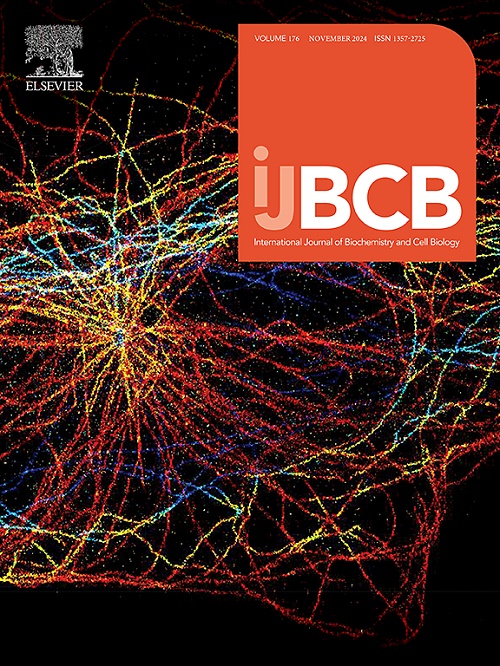结合多组学和单细胞序列分析软组织肉瘤的分子异质性
IF 2.8
3区 生物学
Q2 BIOCHEMISTRY & MOLECULAR BIOLOGY
International Journal of Biochemistry & Cell Biology
Pub Date : 2025-05-15
DOI:10.1016/j.biocel.2025.106801
引用次数: 0
摘要
软组织肉瘤是一种高度恶性的肿瘤,在多个组学中具有广泛的异质性。然而,一个完整的多组学亚型系统尚未建立。方法整合肉瘤多组学数据,包括临床信息、转录组表达谱、DNA甲基化和体细胞突变。使用十种先进的聚类算法,我们确定了稳健的亚型,并在两个独立的外部数据集中验证了我们分析的可重复性。我们还确定了亚型特异性治疗策略,并使用单细胞数据分析了亚型之间微环境的差异。结果基于多组学分型,我们鉴定出两个新的肉瘤分子亚型,分别命名为肉瘤多组学亚型1 (SAMS1)和SAMS2。SAMS2表现出较差的预后,Myc、糖酵解和Wnt β -连环蛋白信号通路显著激活。SAMS2的特点是免疫细胞浸润丰度较低,抗肿瘤免疫缺陷,对免疫治疗的应答率较低,但对某些靶向药物敏感,包括帕唑帕尼、阿西替尼、萨普sigargin和埃司氯莫尔。MK886和NU1025被确定为SAMS2的有效治疗靶点。在sams2样肿瘤上皮细胞中,HOXB13/COL16A1和BASP1调控上皮-间质转化。我们发现WNT7B在STS中高表达,且与患者预后不良相关,提示其有可能成为STS患者新的治疗靶点。结论基于多组学数据的STS分子分型系统可有效鉴别预后不良患者。亚型分型结果稳健可靠,为这些患者的精确诊断和治疗提供了新的见解。本文章由计算机程序翻译,如有差异,请以英文原文为准。
Deciphering the molecular heterogeneity of soft tissue sarcoma by integrating multiomics and single cell sequence
Background
Soft tissue sarcoma is a highly malignant tumor with extensive heterogeneity across multiple omics. However, a comprehensive multi-omics subtyping system has not yet been established.
Methods
We integrated sarcoma multi-omics data, including clinical information, transcriptome expression profiles, DNA methylation, and somatic mutations. Using ten advanced clustering algorithms, we identified robust subtypes and validated the reproducibility of our analysis in two independent external datasets. We also identified subtype-specific treatment strategies and analyzed the differences in microenvironments between subtypes using single-cell data.
Results
Based on multi-omics subtyping, we identified two novel sarcoma molecular subtypes, named sarcoma multi-omics subtype 1 (SAMS1) and SAMS2. SAMS2 exhibited a poorer prognosis, with significantly activated Myc, glycolysis, and Wnt beta-catenin signaling pathways. SAMS2 was characterized by a lower abundance of immune cell infiltration and anti-tumor immunity deficiency, which owned a lower response rate to immunotherapy but was sensitive to certain targeted drugs, including pazopanib, axitinib, thapsigargin, and elesclomol. MK886 and NU1025 were identified as effective therapeutic targets for the SAMS2. In SAMS2-like tumor epithelial cells, HOXB13/COL16A1 and BASP1 regulated epithelial-mesenchymal transition. We found that WNT7B was highly expressed in STS and was associated with poor patient prognosis, suggesting its potential as a novel therapeutic target for STS patients.
Conclusion
The STS molecular subtyping system based on multi-omics data effectively distinguishes patients with poor prognosis. The subtyping results are robust and reliable, providing new insights for the precise diagnosis and treatment of these patients.
求助全文
通过发布文献求助,成功后即可免费获取论文全文。
去求助
来源期刊
CiteScore
8.10
自引率
0.00%
发文量
124
审稿时长
19 days
期刊介绍:
IJBCB publishes original research articles, invited reviews and in-focus articles in all areas of cell and molecular biology and biomedical research.
Topics of interest include, but are not limited to:
-Mechanistic studies of cells, cell organelles, sub-cellular molecular pathways and metabolism
-Novel insights into disease pathogenesis
-Nanotechnology with implication to biological and medical processes
-Genomics and bioinformatics

 求助内容:
求助内容: 应助结果提醒方式:
应助结果提醒方式:


